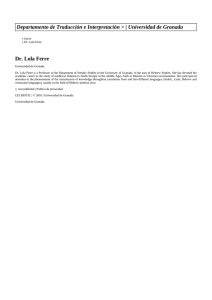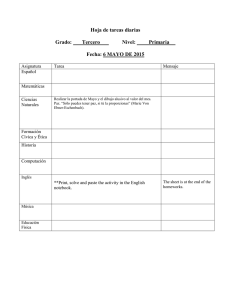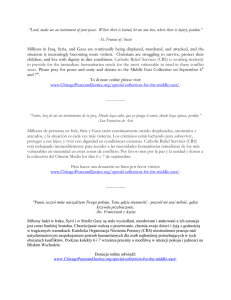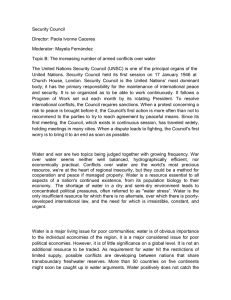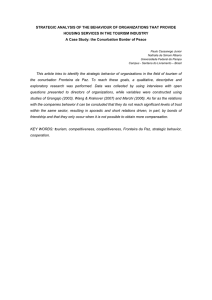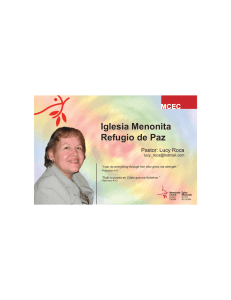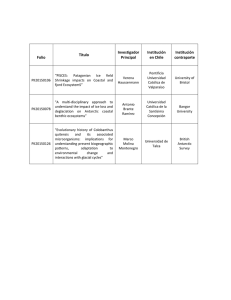Environmental peace (Gaia peace), premises to develop a
Anuncio
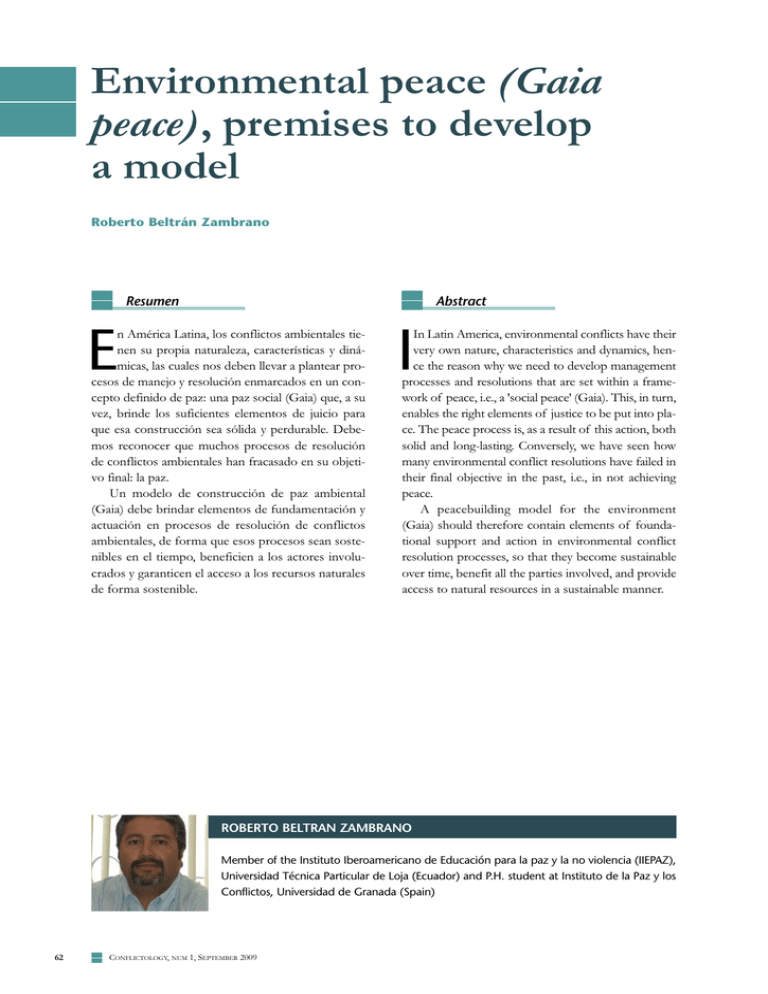
Environmental peace (Gaia peace), premises to develop a model Roberto Beltrán Zambrano Resumen Abstract E n América Latina, los conflictos ambientales tienen su propia naturaleza, características y dinámicas, las cuales nos deben llevar a plantear procesos de manejo y resolución enmarcados en un concepto definido de paz: una paz social (Gaia) que, a su vez, brinde los suficientes elementos de juicio para que esa construcción sea sólida y perdurable. Debemos reconocer que muchos procesos de resolución de conflictos ambientales han fracasado en su objetivo final: la paz. Un modelo de construcción de paz ambiental (Gaia) debe brindar elementos de fundamentación y actuación en procesos de resolución de conflictos ambientales, de forma que esos procesos sean sostenibles en el tiempo, beneficien a los actores involucrados y garanticen el acceso a los recursos naturales de forma sostenible. I In Latin America, environmental conflicts have their very own nature, characteristics and dynamics, hence the reason why we need to develop management processes and resolutions that are set within a framework of peace, i.e., a 'social peace' (Gaia). This, in turn, enables the right elements of justice to be put into place. The peace process is, as a result of this action, both solid and long-lasting. Conversely, we have seen how many environmental conflict resolutions have failed in their final objective in the past, i.e., in not achieving peace. A peacebuilding model for the environment (Gaia) should therefore contain elements of foundational support and action in environmental conflict resolution processes, so that they become sustainable over time, benefit all the parties involved, and provide access to natural resources in a sustainable manner. ROBERTO BELTRAN ZAMBRANO Member of the Instituto Iberoamericano de Educación para la paz y la no violencia (IIEPAZ), Universidad Técnica Particular de Loja (Ecuador) and P.H. student at Instituto de la Paz y los Conflictos, Universidad de Granada (Spain) 62 CONFLICTOLOGY, NUM 1, SEPTEMBER 2009 INTRODUCTION The current efforts of conflictology and of those working on peace research demand both the application of concepts and the development of new theoretical proposals that provide peace and their study with construction, development, and research. These are the major management elements in order to get new social agents implied for peace. Latin America is a region with several kinds and degrees of conflicts. Its inestimable natural richness turns it into the region of hope for the world’s future but, at the same time, into an attractive place to exploit its natural resources. This combination of needs, together with the slow progress of agreed environmental management, has generated a series of conflicts related with the environment. Several initiatives on the resolution of environmental conflicts have been developed in several countries of the area1 with positive results. In spite of that, the degree of conflictivity and violence is worrying2 and, therefore, it is necessary to go further. That is to say, to develop models of environmental conflicts management based on a Gaia peace concept to grant the initiatives’ orientation and the strengthening of a peace culture. ENVIRONMENTAL CONFLICTS: VIOLENCE, PEACE, AND NON-VIOLENCE We must add the concept of environmental peace or Gaia to those of internal peace and social peace, 1 2 3 since it is the natural or ecological dimension of peace.3 It is a concept that we must also develop under the perspective of social peace [Galtung, 1998] or neutral peace [Jiménez, 2004], because the Gaia peace must include the different knowledges of “peaces” and incorporate them into everyday coexistence. This is its main challenge. It is necessary to point out that the resolution of environmental conflicts, from the Peace Research (PR), is in line with the studies carried out on negative peace, positive peace, and neutral peace as well as with the contributions made by Johan Galtung about peace [1985, 2003], of which come out three starting axioms: a. The “peace” term will be used to refer to social objectives commonly accepted by many people. b. These social objectives might be complex and difficult, but not impossible to achieve. c. We take the following statement as valid: “peace” is the absence of “violence”. As for this work, we will point out the definitions of the three kinds of peace and their relationship with violence in order to show, thus, which is the link with the resolution of border conflicts related with water management. We will use the studies by Jiménez Bautista (2004), who compiles the work on this issue made by other authors. What we understand by negative peace is the absence of war, armed conflicts or explicit violence, from the point of view of war between states or groups of people. What we understand by positive peace is the absence of structural or indirect violence, typical of social structures with inequalities of some kind For further detail you can look at the papers by Red Mesoamericana de Manejo de Conflictos Ambientales and by Plataforma de Acuerdos Socioambientales (Ecuador). Salama Pierre, (2008) “Informe sobre la Violencia en América Latina”, Revista de Economía Institucional, Universidad Externado de Colombia, Vol. 10 Nº 10, Primer Semestre/pp. 81-102 LOPEZ MARTÍNEZ, Mario (ed), (2004). “Enciclopedia de Paz y Conflictos”, Tomo II, Instituto de la Paz y los Conflictos,Universidad de Granada CONFLICTOLOGY, NUM 1, SEPTEMBER 2009 63 ROBERTO BELTRÁN ZAMBRANO (social, economic, politic or military). And by neutral peace we understand the absence of cultural violence. In these three definitions, the word violence appears in different spheres: direct, structural, and cultural. This is a really useful difference when analyzing conflicts with a view to resolution. The different peace concepts are related to the different violence concepts. Therefore, direct violence is the one related to visible signs affecting people or things. Structural violence is related to those elements developed by social structures causing inequality. Finally, cultural violence is related to a series of paradigms, behaviours, and social tendencies leading to lack of equity, inequality, and disintegration of coexistence models. The different kinds of violence, viewed from the research and culture for peace, must be coped with from a non-violent perspective preventing the vicious circle of violence to reproduce and grow. In some societies, the rise in law regulations on environmental management and govern is being discussed. The question is: are new regulations necessary? Would it be necessary to improve the existing ones? Would it be indispensable to build peace concepts and models including the relationship of humans with the environment and with the management of use and access to the different resources? On the other hand, the conflicts arising from the exploitation of natural resources and from the relationship man-nature, generally have an only way of regulation: the litigious one. Would it be possible to count on alternative tools to deal with border conflicts from the perspective of environmental peace? Is it possible to develop essential elements to build a model of Gaia peace?4 One of the dangers that environmental government and management has to face is not shortage management, but the intention of a country or a group of countries to dominate or regulate its usage for a particular and restricted purpose. Thus, environmental conflicts5 with special characteristics arise: kind of conflicts is typically seen with a focus on the consequences, on the analysis of the development of banning regulations, rather than on incentives. • The second characteristic of this conflict is that the above mentioned process has a public nature, since it includes aspects of public and collective interest (e.g., water as a public good). This is an enormously relevant characteristic when working with a Gaia peace model since several LatinAmerican countries have developed privatisation policies for the management of natural resources, thus limiting the participation of the State and of the implied communities in the decision making and the management of conflicts. Therefore, the only way left to solve these controversies is the recourse to law (public) or arbitration (private). • The third characteristic of this kind of conflicts is that they involve collective actions, where groups of people or institutions introduce actions with a public nature. This characteristic, in relation with the previous one, has a problem when setting out a model of conflict management since the parties; generally, react according to their interests without taking into consideration the systematic vision of the problem. • The fourth characteristic of this kind of conflict is related to the presence of a diversity of values, perceptions or meanings that the implied actors give to the actions or circumstances affecting or able to affect, the management of natural resources (use, access, legislation, administration, limitations, etc.). • Finally, the fifth characteristic of this kind of conflicts is that they are related to the dynamics of opposition, controversy, argument or protest among those actors and, consequently, there is a recognition of the opposing actors in the conflict, no matter the claims being considered legitimate or worthy of consideration. • The first characteristic of this kind of conflict is that it is a process. It has a time line, causes, a place, actors, and consequences. In general, this Some authors6 consider that three phases can be established in the search of solutions to environmental problems: 4 5 6 64 ENVIRONMENTAL PEACE (GAIA PEACE), PREMISES TO DEVELOP A MODEL JIMENEZ BAUTISTA, Francisco, (2004). “Propuesta de una Epistemología Antropológica para la Paz”, CONVERGENCIA, Revista de Ciencias Sociales, January-April, year/volume 11, number 034, Toluca, México. Centro Mexicano de Derecho Ambiental, (2000). “Manual de Identificación y Caracterización de Conflictos en Áreas Prioritarias para la Conservación”. México. GUTIERREZ PEREZ, José, (2004), in LÓPEZ MARTINEZ, Mario (Dir.), Enciclopedia de Paz y Conflictos, Tomo I, A-K. Granada, Ed. Universidad de Granada. CONFLICTOLOGY, NUM 1, SEPTEMBER 2009 ROBERTO BELTRÁN ZAMBRANO ENVIRONMENTAL PEACE (GAIA PEACE), PREMISES TO DEVELOP A MODEL a. Defining the conflict. To state the current situation, people’s perception of the conflict, the fears, the wishes, the worries. To understand the conflict’s time line: what was the cause? What situation made it grow? b. Delimiting the conflict. Both in time and magnitude. Affected sectors, natural resources, people, organizations, and groups being involved. In general, the past, the present, and the future of the conflict. c. Drawing up solutions. As usual, this is the most complex and delicate phase since the solutions must be balanced and conceived as long-term solutions. For the building up of environmental agreements, it is important that everybody has the right information, updated at the moment of making decisions or of choosing the best solution. This is also a complex phase because at this point, the group pressures appear more clearly. This is why it is important to describe the main and the supporting actors. Taking into consideration the legislation of the country and the region as well as the government’s official stance contributes to the conflicts having a legal and political support. ENVIRONMENTAL PEACE: ‘GAIA PEACE’ What we try to develop at the Instituto Iberoamericano de Educación para la Paz y la No Violencia (IIEPAZ, Iberoamerican Institute for Peace and Nonviolence Education) is a definition more in line with the treatment of environmental conflicts. Our intention is to gather the different researches related to this issue and enlarge, in the first place, the concept of environmental peace applicable to our environment and, secondly, the model of environmental conflicts management in order to make it useful for the implied actors. Environmental law and law regulations are key elements of this task. We must think of the ecological or natural dimension of peace in order to develop a concept of environmental peace from the environmental ethics (Leff, 1990). Taking as a basis the works done by Lovelock (1979) and Margulis (1989) as well as the peace works by Galtung (1985), the environmental peace or Gaia peace leads us to think about conflicts management not just from a single perspective, but from many. Per- 7 haps from all the perspectives taking part in conflicts, bearing always in mind that what binds or divides the parties in this kind of conflicts will always be natural resources. How to solve the conflicts coming out from water management? Our proposal is summarized in the graphic below, which we will try to explain: A GAIA7 peace management model Understanding Recognition Action Beltran, 2008 The premises to build up an environmental peace, through which we will develop conflicts resolution processes, are: a. Recognition. As a result of a whole process allowing the parties to accept the conflict’s presence. In the case of border waters management, for instance: • Sustainability crisis: led by land defence movements against big hydraulic projects and pollution problems. • Government crisis: a strong movement defending human and citizens’ rights against the privatization of water and drains basic services. • Food crisis: direct or indirect impacts on the world’s food production sources which are induced by the breakdown of the hydrologic cycle and by the sustainability crisis of rivers, lakes and water lands. • Socio-economic crisis: side impacts related to desertification, migration, land invasion and militarization of agricultural production areas. b. Understanding. As an element of transition from a negative peace to a neutral peace. It is very important to consider understanding as a premise of Gaia peace since in this phase a series of processes occur that allow having a vision of the conflict free of Beltrán, 2008, based on the work by Lovelock [1983]. CONFLICTOLOGY, NUM 1, SEPTEMBER 2009 65 ROBERTO BELTRÁN ZAMBRANO ENVIRONMENTAL PEACE (GAIA PEACE), PREMISES TO DEVELOP A MODEL paradigms preventing its systemic understanding. From another point of view, the understanding phase allows us to have data about the reality of similar conflicts in other regions, about indicators letting us know about the resources’ situation, water in this case, about beneficiaries or affected people, about the results of an appropriate or inappropriate conflict management. It is impossible for the resolution measures to have a positive long-term effect without the complete development of this phase. c. Action. It is the result of the two previous premises. Although it may not always appear in the last place and we may need the States to act in direct violence cases, action as a premise of environmental peace is the result of the parties’ willingness for the good of all (neutral peace). In this phase we can find written agreements, law regulations, verbal engagements, behaviours, and changes in societies’ legal, social, and environmental culture. When talking about Gaia peace, we are talking about symbiosis, long-lasting reciprocally beneficial relationship to be visible in the inner and external life of people and societies. AS A CONCLUSION Resolution of environmental conflicts is not only about the application of tools settled by laws or agreements (mediation or arbitration). It is essential to understand the environmental conflicts, its nature, characteristics, and dynamics in order to set out management and resolution processes, which must be based on a social peace concept (Gaia) providing with sufficient information for the construction to be solid and long-lasting. Conflicts resolution, in itself, does not have any sense, if it is not in line with the processes and concepts of social peace (Gaia). Every conflict management must be originated and based on concepts supporting the process in the long run. The function of environmental peace (Gaia) is to bring foundation and action elements to the processes of environmental conflicts resolution, so that, those conflicts will be sustainable in time, will benefit the involved actors, and will grant a sustainable access to the natural resources. Only in this way the actors of environmental conflicts will see Gaia peace as a credible and long-lasting proposal. BIBLIOGRAPHY USED AGUILAR ALEJANDRA, PANIAGUA FRANKLIN, GARITA ANA, Red Mesoamericana de Manejo de Conflictos Socioambientales, (1999). Conflicto y Colaboración en el Manejo de Recursos Naturales: programa de pequeños fondos para investigación en América Latina - Conflictos socio ambientales en América Latina: una visión desde la Red Mesoamericana de Manejo de Conflictos Socio Ambientales. Canadá. Centro Internacional de Investigación para el Desarrollo (CIID) - Internacional Development Research Centre (IDRC). BELTRÁN ZAMBRANO, ROBERTO (2001). “Liderazgo y Técnicas de Negociación. Guía didáctica”. , Ed. Universidad Técnica Particular de Loja BELTRÁN ZAMBRANO, ROBERTO (2003). “Apuntes para el estudio de los conflictos socioambientales”. Text and teacher’s book. Escuela de Ciencias Ambientales, Ed. Universidad Técnica Particular de Loja 66 CONFLICTOLOGY, NUM 1, SEPTEMBER 2009 BELTRAN ZAMBRANO, ROBERTO (2004). Conflictos socioambientales: introducción, manejo y estrategias de intervención, Cuaderno de Trabajo. Fundación Ecológica Arcoiris - Centro de Análisis y Resolución de Conflictos, CENARC-UTPL. Ed. Universidad Técnica Particular de Loja BELTRAN ZAMBRANO, ROBERTO (2007). Memoria histórica e impacto socio-político de los Conflictos Medio-Ambientales del Ecuador (último período republicano, 1978-2006), dissertation for the Degree on Advanced Studies of the doctorate Peace, Conflicts and Democracy, Instituto de la Paz y los Conflictos, Universidad de Granada. Granada BRUNDTLAND. Colección estructuras y procesos - serie medio ambiente. Madrid-España. Editorial Trotta. CARPINTERO REDONDO, ÓSCAR (1999). Entre la economía y la naturaleza - La controversia ROBERTO BELTRÁN ZAMBRANO ENVIRONMENTAL PEACE (GAIA PEACE), PREMISES TO DEVELOP A MODEL sobre la valoración monetaria del medio ambiente y la sustentabilidad del sistema económico. MadridEspaña. 1st edición. Editorial Los Libros de la catarata. CENTRO MEXICANO DE DERECHO AMBIENTAL (2000). “Manual de Identificación y Caracterización de Conflictos en Áreas Prioritarias para la Conservación”. México. CORREA HERNAN DARIO, RODRÍGUEZ LOKINEZ (editores), (2005). Encrucijadas Ambientales en América Latina - Entre el manejo y la transformación de conflictos por recursos naturales. 1st edition. San José-Costa Rica. Programa C y C Universidad para la Paz. DOBSON, ANDREW (1997). Pensamiento político verde - Una nueva ideología para el siglo XXI. Barcelona-España. 1st edition. Editorial Paidós Ibérica S.A. DRUCKMAN DANIEL, ROBINSON VICTOR (1998). Curso de Negociación Aplicada: Análisis y Estrategias. Fairfax, Virginia, USA. Institute for Conflict Analysis and Resolution, George Mason University. FERNÁNDEZ HERRERÍA, ALFONSO (Editor), (1997). Educando para la Paz: Nuevas propuestas. Granada. Editorial Universidad de Granada. FISAS, Vicent, (1998). Cultura de Paz y Gestión de Conflictos. Barcelona. Icaria. UNESCO. GALTUNG, JOHAN (1998). Tras la violencia - 3R: reconstrucción, reconciliación, resolución Afrontando los efectos visibles e invisibles de la guerra y la violencia. Bilbao. Colección Red Gernika Gogoratuz. GALTUNG, JOHAN (2003). Paz por Medios Pacíficos: Paz y Conflicto, Desarrollo y Civilización. Bilbao-España. Gernika Gogoratuz. GALTUNG, JOHAN (2003). Violencia cultural. Gernika-Lumo: Gernika Gogoratuz, GUDYNAS, E. (1992). Los múltiples verdes del ambientalismo latinoamericano. Nueva Sociedad 122:104-115. JAQUENOD DE ZSOGON, SILVIA; ZSOGON BENCZINK, ESTEBAN (1990). Evaluación del manejo y explotación de los recursos naturales de uso agrario en Iberoamérica desde la época prehispánica, y sus repercusiones socioambientales actuales: Madrid. Auspiciante Comisión Nacional Quinto Centenario del Descubrimiento de América. JAQUENOD DE ZSOGON, SILVIA (2004). Derecho Ambiental. Madrid-España. 2nd edition. Editorial Dykinson, S. L. JIMENEZ BAUTISTA, FRANCISCO (2004). “”Propuesta de una Epistemología Antropológica para la Paz”, CONVERGENCIA, Revista de Ciencias Sociales, January-April, year/volume 11, number 034, Toluca, México KANT, EMMANUEL (1990). La Paz Perpétua. México. Ed. Porúa. LEDERACH, JOHN PAUL (1998). Construyendo la paz - Reconciliación sostenible en sociedades divididas. Bilbao-Bakeaz. Colección Red Gernika Gogoratuz. LEDERACH, JUAN PABLO (1992), Enredos, Pleitos y Problemas. Una guía práctica para ayudar a resolver conflictos, Colombia, Clara Semilla. LEDERACH, JUAN PABLO; CHUPP, MARCOS (1998), ¿Conflicto y Violencia?, ¡Busquemos alternativas creativas!, Guía para facilitadores, Bogotá, Ediciones Clara Semilla. LEFF, E. (1990) (Ed). Los Problemas del Conocimiento y la perspectiva Ambiental del Desarrollo - Siglo XXI. Eds. México. LÒPEZ MARTINEZ, MARIO (2004). Enciclopedia de Paz y Conflictos, Tomo I, A-K. Granada, Ed. Universidad de Granada. LÒPEZ MARTINEZ, MARIO (2004). Enciclopedia de Paz y Conflictos, Tomo II, L-Z. Granada, Ed. Universidad de Granada. LÓPEZ MARTÍNEZ, MARIO (2001). La noviolencia como alternativa política, en Fco. A. Muñoz (ed.) La Paz Imperfecta. Granada, Ed. Universidad de Granada, pp. 181-251. LÓPEZ MARTÍNEZ, MARIO. La sociedad civil por la paz, en Fco. A. Muñoz Y López Martínez, Mario (eds.) Historia de la Paz. Tiempos, espacios y actores. Granada, Ed. Universidad de Granada, 2000, pp. 291-357. LÓPEZ MARTÍNEZ, MARIO. Métodos y Praxis de la Noviolencia. International Conference on Peace Building. Pontificia Universidad Javeriana.2003. LÓPEZ MARTÍNEZ, MARIO. Noviolencia para generar cambios sociales visibles”, Polis, nº 9, San- CONFLICTOLOGY, NUM 1, SEPTEMBER 2009 67 ROBERTO BELTRÁN ZAMBRANO ENVIRONMENTAL PEACE (GAIA PEACE), PREMISES TO DEVELOP A MODEL tiago de Chile, Universidad Bolivariana, 2004a. LÓPEZ MARTÍNEZ, MARIO. Noviolencia, política y ética, en VV.AA. El Poder de la Fragilidad. Bogotá, Ed. Kimpres Ltda., 2003, pp. 95-131. LÓPEZ R., FAUSTO (2002). Ecuador -Perú; Conservación para la Paz. Loja-Ecuador. Editorial Universidad Técnica Particular de Loja. LÓPEZ R., FAUSTO (2005). El parque nacional Podocarpus: agua y biodiversidad - Usos y beneficios para la región sur del Ecuador. Loja-Ecuador. Impresión Industrial GráficAmazonas Cía. Ltda. LOVELOCK, J. (1983), Madrid: Hermann Blumme RIOJA, G. (1991). Proyecto Jatata: experiencia pilo- 68 CONFLICTOLOGY, NUM 1, SEPTEMBER 2009 to de autogestión Chimane. Presencia (La Paz, Bolivia). Domingo 7 de Julio. SWAIN, ASHOK (1993). Environment and Conflict: Analysing the Developing World. Repro Ekonomikum, Uppsala. Report No. 37, Department of Peace and Conflict Research. Uppsala University. VINYAMATA CAMP, EDUARD (2005). Conflictología - Curso de Resolución de Conflictos. Barcelona-España. Editorial Ariel, S.A. VINYAMATA CAMP, EDUARD (2003). Aprender mediación. Barcelona- España. Ediciones Paidós Ibérica S.A.
